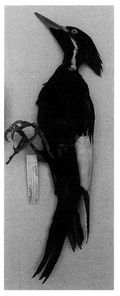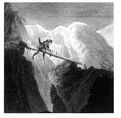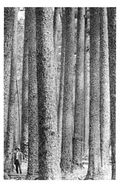The Race to Save the Lord God Bird (19 page)
Read The Race to Save the Lord God Bird Online
Authors: Phillip Hoose


A Note on Sources
This book was a journey for me in two ways. First, it let me write on things I've been thinking about for more than thirty years as an environmentalist and conservationist. I've long been fascinated by the Ivory-billed Woodpecker. I went looking for it myself in the Big Thicket Swamp in Texas in 1980âit was so hot that day I had to carry my dog out. Alas, there were no Ivory-bills, or if there were, they kept out of sight. Second, it was an actual journey in that I hit the road. In a year's time, this book took me to Louisiana, Mississippi, Tennessee, Massachusetts, New York, and Cuba. Often, my most important sources were the people I met and interviewed during this journey.
Research in Cuba was especially exciting. Scouring the island, I found most of the people who had most recently seen the Ivory-bill. I met artists, biologists, stamp collectors, foresters, museum curators, and guides who knew the Ivory-bill in their own ways. Several Cuban educators told me that their students are hungry to learn more about birds, but that poverty forces them to study without binoculars, field guides, drawing paper, even pens and pencils. So, along with several colleagues, I helped start a fund to buy and deliver the supplies they need. For more information on how you can help the Birders' Exchange Cuba Initiative program, see
www.americanbirding.org/bex
.
www.americanbirding.org/bex
.
General Sources: Books and Magazines
Several books and magazines were more important to my research than all the others:
James T. Tanner,
The Ivory-billed Woodpecker,
Audubon Society Research Report No. 1
The Ivory-billed Woodpecker,
Audubon Society Research Report No. 1
(New York: Dover Press, 1942). It's the bible for the Ivory-bill. I first read this book in the 1970s, when I was just beginning my own career as a conservationist. It remains the best study of a single species I've ever read.
Peter Matthiessen,
Wildlife in America
(New York: Viking, 1959). This book gives a detailed snapshot of endangered species in the United States nearly a half century ago.
Wildlife in America
(New York: Viking, 1959). This book gives a detailed snapshot of endangered species in the United States nearly a half century ago.
Christopher Cokinos,
Hope Is the Thing with Feathers
(New York: Warner Books, 2000). Having read Tanner's book about the Ivory-bill, I thought I knew the story of its decline. But Christopher Cokinos broke new ground. His wonderful bookâabout the disappearance of six American bird speciesâtaught me more and made me want to know much more about the Ivory-bill in the United States and in Cuba. And he left a trail of sources behind that I could research.
Hope Is the Thing with Feathers
(New York: Warner Books, 2000). Having read Tanner's book about the Ivory-bill, I thought I knew the story of its decline. But Christopher Cokinos broke new ground. His wonderful bookâabout the disappearance of six American bird speciesâtaught me more and made me want to know much more about the Ivory-bill in the United States and in Cuba. And he left a trail of sources behind that I could research.
David Allen Sibley, ill.,
The Sibley Guide to Bird Life and Behavior
(New York: Knopf, 2001). What a treasure! I constantly turned to this beautiful book when I wanted to know something about why birds act as they do.
The Sibley Guide to Bird Life and Behavior
(New York: Knopf, 2001). What a treasure! I constantly turned to this beautiful book when I wanted to know something about why birds act as they do.
The Auk.
For more than one hundred years,
The Auk,
a quarterly journal of the American Ornithologists' Union, has published original reports on the biology of birds. Tanner, Wayne, Allen, Brewster, Chapman, and other figures in this book published articles in
The Auk,
and, with the help of librarians at Bowdoin College in Maine, I turned to it again and again.
For more than one hundred years,
The Auk,
a quarterly journal of the American Ornithologists' Union, has published original reports on the biology of birds. Tanner, Wayne, Allen, Brewster, Chapman, and other figures in this book published articles in
The Auk,
and, with the help of librarians at Bowdoin College in Maine, I turned to it again and again.
Frank Graham, Jr.,
The Audubon Ark: A History of the National Audubon Society
(New York: Knopf, 1990). By far the best single source of information I found on the history of the Audubon Society and the Plume War.
The Audubon Ark: A History of the National Audubon Society
(New York: Knopf, 1990). By far the best single source of information I found on the history of the Audubon Society and the Plume War.
Barbara and Richard Mearns,
The Bird Collectors
(San Diego: Academic Press, 1998). Here is a gold mine of information on collectors and collecting, covering everything from Ward's Natural Science Establishment to a ranked list of the greatest collections of bird specimens in the world.
The Bird Collectors
(San Diego: Academic Press, 1998). Here is a gold mine of information on collectors and collecting, covering everything from Ward's Natural Science Establishment to a ranked list of the greatest collections of bird specimens in the world.
Fortunately, the Ivory-bill was so striking in appearance that many of the people who saw it wrote something about it. Here are the more important sources by chapter.
Prologue. The Hostage
Alexander Wilson's famous account of trying to keep an Ivory-bill in his hotel room appears in his
American Ornithology
as part of a long description of the Ivory-billed Woodpecker. I used the Brewer edition (Boston, 1840), pp. 272â79. All quotes attributed to Wilson in “The Hostage” are from this book, including the opening quote on p. 7. For more information about Wilson's life and times, I turned especially to Robert Cantwell,
Alexander Wilson: Naturalist and Pioneer, a Biography
(Philadelphia: Lippincott, 1961). The quote from Charles Leslie in the sidebar on p. 9 is from Cantwell, p. 144.
American Ornithology
as part of a long description of the Ivory-billed Woodpecker. I used the Brewer edition (Boston, 1840), pp. 272â79. All quotes attributed to Wilson in “The Hostage” are from this book, including the opening quote on p. 7. For more information about Wilson's life and times, I turned especially to Robert Cantwell,
Alexander Wilson: Naturalist and Pioneer, a Biography
(Philadelphia: Lippincott, 1961). The quote from Charles Leslie in the sidebar on p. 9 is from Cantwell, p. 144.
Chapter One. Specimen 60803
I visited the Louisiana State University Museum of Natural Science in January 2002. Dr. James Van Remsen showed me Ivory-bill specimens and patiently answered questions about the species' life history. Much in this chapter is based on this interview.
“Weight-Saving Features” (sidebar, p. 14): I especially used Sibley and Dr. Ernst Mayr,
What Evolution Is
(New York: Basic Books, 2001), in order to understand more about how birds evolved and why they are formed as they are and behave as they do.
What Evolution Is
(New York: Basic Books, 2001), in order to understand more about how birds evolved and why they are formed as they are and behave as they do.
A good discussion of Darwin's finches (sidebar, p. 15) is found in Roger F. Pasquier,
Watching Birds: An Introduction to Ornithology
(Boston: Houghton Mifflin, 1977), pp. 24â27.
Watching Birds: An Introduction to Ornithology
(Boston: Houghton Mifflin, 1977), pp. 24â27.
To learn about the structure and behavior of woodpeckers, I consulted Dr. Lester L. Short,
Woodpeckers of the World
(Greenville, Del.: Weidner & Sons/Delaware Museum of Natural History, 1982), and T. Gilbert Pearson, “Woodpeckers, Friends of Our Forests,”
National Geographic,
vol. 63, no. 4 (April 1933).
Woodpeckers of the World
(Greenville, Del.: Weidner & Sons/Delaware Museum of Natural History, 1982), and T. Gilbert Pearson, “Woodpeckers, Friends of Our Forests,”
National Geographic,
vol. 63, no. 4 (April 1933).
Almost all material on George E. Beyer, including the quote on p. 18 from Beyer to W. D. Rogers, came from materials in a file under Beyer's name in the Special Collections Division of the Tulane University Library. The newspaper article about Beyer's experiment with rattlesnake venom is from
The Daily Picayune
(New Orleans) of September 2, 1905. Quotes on p. 18 in which Beyer describes collecting Ivory-bills are from his article “The Ivory-billed Woodpecker in Louisiana,” in
The Auk,
vol. 17, no. 2 (April 1900).
The Daily Picayune
(New Orleans) of September 2, 1905. Quotes on p. 18 in which Beyer describes collecting Ivory-bills are from his article “The Ivory-billed Woodpecker in Louisiana,” in
The Auk,
vol. 17, no. 2 (April 1900).

Chapter Two. Audubon on the Ivory-billed Frontier
The introductory quote (“He neglects his material interests”) appeared in an article by Michael Harwood and Mary Durant, “In Search of the Real Mr. Audubon,” in
Audubon Magazine,
vol. 87, no. 3 (May 1985), p. 63. John James Audubon's descriptions of the Ivory-billed Woodpecker, its voice, its habitat and behavior, and the quotes about the killing of Ivory-bills by Indians and settlers appear in Audubon's
The Birds of America
(New York: J. J. Audubon; Philadelphia: J. B. Chevalier, 1840â44). Besides Audubon's great paintings, one can find nearly five hundred fascinating descriptions of the birds Audubon encountered. For biographical information about Audubon, I turned to several books, especially Shirley Streshinsky,
Audubon: Life and Art in the American Wilderness
(New York: Villard Books, 1993), Alice Ford,
John James Audubon
(Norman: University of Oklahoma Press, 1964), and Alexander B. Adams,
John James Audubon:
A
Biography
(New York: G. P. Putnam's Sons, 1966).
Audubon Magazine,
vol. 87, no. 3 (May 1985), p. 63. John James Audubon's descriptions of the Ivory-billed Woodpecker, its voice, its habitat and behavior, and the quotes about the killing of Ivory-bills by Indians and settlers appear in Audubon's
The Birds of America
(New York: J. J. Audubon; Philadelphia: J. B. Chevalier, 1840â44). Besides Audubon's great paintings, one can find nearly five hundred fascinating descriptions of the birds Audubon encountered. For biographical information about Audubon, I turned to several books, especially Shirley Streshinsky,
Audubon: Life and Art in the American Wilderness
(New York: Villard Books, 1993), Alice Ford,
John James Audubon
(Norman: University of Oklahoma Press, 1964), and Alexander B. Adams,
John James Audubon:
A
Biography
(New York: G. P. Putnam's Sons, 1966).

Audubon kept a journal of his daily observations during his 1820â1821 voyage down the Ohio and Mississippi rivers with Joseph Mason and also wrote about a few months they spent together in New Orleans. It is here that I found Audubon's quotes about Mason and his description of shooting an Ivory-billed Woodpecker. I used
Journal of John James Audubon, 1820â1821
(Boston: Club of Odd Volumes, 1929).
Journal of John James Audubon, 1820â1821
(Boston: Club of Odd Volumes, 1929).
Also, there have been two good books of fiction about Joseph Mason for young readers.
While I couldn't quote from them in this nonfiction book, they provided a good sense of Mason's amazing adventures with Audubon. They are Barbara Brenner,
On the Frontier with
Mr.
Audubon
(Honesdale, Pa.: Boyds Mills Press; reprint edition, 1997), and Charlie May Simon,
Joe Mason: Apprentice to Audubon
(New York: E. P. Dutton, 1946).
While I couldn't quote from them in this nonfiction book, they provided a good sense of Mason's amazing adventures with Audubon. They are Barbara Brenner,
On the Frontier with
Mr.
Audubon
(Honesdale, Pa.: Boyds Mills Press; reprint edition, 1997), and Charlie May Simon,
Joe Mason: Apprentice to Audubon
(New York: E. P. Dutton, 1946).
The quotes on p. 24 from Mark Catesby come from a volume that is usually considered to be the first American natural history. Catesby was a British gentleman trained in botany and natural history. A century after the British finally established colonies in the New World, he hungered to see the region's fabled plants and animals. After his sister Elizabeth moved to Williamsburg, Virginia, Catesby used her home as a base and spent ten years exploring Britain's southern colonies in America between 1712 and 1725. He collected specimens, took careful notes, and painted watercolors. Then he returned to London and spent twenty years writing up his findings. When he was ready, he dedicated his two-volume work to Queen Caroline and gave it a title that can hardly be said in one breath:
The Natural History of Carolina, Florida and the Bahama Islands: Containing the Figures of Birds, Beasts, Fishes, Serpents, Insects and Plants ⦠To which are added, Observations on the Air, Soil, and Waters: With Remarks upon Agriculture, Grain, Pulse, Roots, &c.
I found Catesby's work on microfilm at the University of Southern Maine.
The Natural History of Carolina, Florida and the Bahama Islands: Containing the Figures of Birds, Beasts, Fishes, Serpents, Insects and Plants ⦠To which are added, Observations on the Air, Soil, and Waters: With Remarks upon Agriculture, Grain, Pulse, Roots, &c.
I found Catesby's work on microfilm at the University of Southern Maine.
Chapter Three. “The Road to Wealth Leads Through the South”
A good book for learning about the southern lumber boom is historian C. Vann Woodward's
Origins of the New South: 1877â1913
(Baton Rouge: Louisiana State University Press, 1971). Chauncy Depew's quote at the beginning of the chapter is from p. 115 of this book. Woodward describes the feverish sale of southern forested land at the end of Reconstruction and the great desire of Northerners to get at it. The quotes on p. 33 from “a Chattanooga, Tennessee, newspaper” and from a “government forestry expert” are also from Woodward, both on p. 118. Mary E. Tebo shared additional insights through her excellent, as yet unpublished master's study, conducted for Florida State University, entitled “The Southeastern Piney Woods: Describers, Destroyers, Survivors.”
Origins of the New South: 1877â1913
(Baton Rouge: Louisiana State University Press, 1971). Chauncy Depew's quote at the beginning of the chapter is from p. 115 of this book. Woodward describes the feverish sale of southern forested land at the end of Reconstruction and the great desire of Northerners to get at it. The quotes on p. 33 from “a Chattanooga, Tennessee, newspaper” and from a “government forestry expert” are also from Woodward, both on p. 118. Mary E. Tebo shared additional insights through her excellent, as yet unpublished master's study, conducted for Florida State University, entitled “The Southeastern Piney Woods: Describers, Destroyers, Survivors.”

To learn about the clearing of northern forests, I turned to Matthiessen,
Wildlife in America,
and to several Web sites, especially Andy Hiltz, “Logging the Virgin Forests of West Virginia” (
www.patc.net/history/archive/virgfst.html
). Cotton Mather's quote on p. 30 came from Matthiessen, p. 56, and Daniel Boone's remark to Audubon on p. 31 is also from Matthiessen, p. 112. I found Thomas Nuttall's opinion on p. 33 that the Ivory-bill was restricted to the Gulf States and Lower Mississippi Valley in his A
Popular History of the Ornithology of Eastern North America
(Boston: Little, Brown, 1896), p. 443. I turned to my own article “A Stand for the Ages” for information about the history and destruction of the virgin forests in the upper Connecticut River valley in New Hampshire. Detailing how the last stand of virgin spruce in New Hampshire was saved by a visionary forester, it appears in
Nature Conservancy
magazine, vol. 38, no. 5 (September 1988).
Wildlife in America,
and to several Web sites, especially Andy Hiltz, “Logging the Virgin Forests of West Virginia” (
www.patc.net/history/archive/virgfst.html
). Cotton Mather's quote on p. 30 came from Matthiessen, p. 56, and Daniel Boone's remark to Audubon on p. 31 is also from Matthiessen, p. 112. I found Thomas Nuttall's opinion on p. 33 that the Ivory-bill was restricted to the Gulf States and Lower Mississippi Valley in his A
Popular History of the Ornithology of Eastern North America
(Boston: Little, Brown, 1896), p. 443. I turned to my own article “A Stand for the Ages” for information about the history and destruction of the virgin forests in the upper Connecticut River valley in New Hampshire. Detailing how the last stand of virgin spruce in New Hampshire was saved by a visionary forester, it appears in
Nature Conservancy
magazine, vol. 38, no. 5 (September 1988).
Other books
Dirty Deeds by Armand Rosamilia
The Heir by Kiera Cass
Ammie, Come Home by Barbara Michaels
Plaything: Volume Two by Jade West, Jason Luke
Advent Calendar (An Erotic / Erotica Paranormal Tale) by Selena Kitt
Mixing Temptation by Sara Jane Stone
Finding My Way by Keith, Megan
Southern Hearts (Southern Love Series) by Thorn, Ava
Asesinato en Mesopotamia by Agatha Christie
The Slayer by Theresa Meyers
